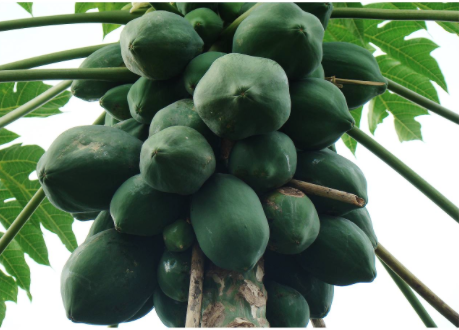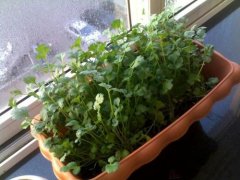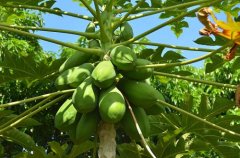A brief introduction to Hawaiian papaya, what is the output of Hawaiian papaya? is the price high?
Hawaiian papaya is a kind of papaya grown in Hawaii. Do you know this kind of papaya? If you want to know the output and price of Hawaiian papaya, let's take a look!
Papaya industry in Hawaii. Papaya has been grown in Hawaii for more than a century. For the papaya industry around the world, the main production restriction is papaya rotavirus (PRSV), a virus found in potatoes that spreads rapidly through some sprouts in an unsustainable way. Although PRSV was discovered in the mid-1940s, it was not until the 1950s that it became a major problem in the papaya industry in Hawaii. At that time, the main producing area of Hawaiian papaya industry was Oahu, and PRSV had seriously affected the papaya industry on the island in the late 1950s and early 1960s.
Later, due to the environmental advantages of Puna District on the Big Island of Hawaii, the papaya industry was replanted to Puna District of Hawaii Island, where there is sufficient and low-cost land to rent, sufficient rainfall and sunshine, and an excellent variety of papaya "Kapoho", which is very rare to adapt to the regional environment, and most importantly, there is no PRSV in the area. In the 1970s, nearly 95% of Hawaii's papaya growing area (about 2500 acres) was located in the Puna district of Hawaii's Big Island. However, PRSV was found in Puna in May 1992, and the virus spread very rapidly, and the Hawaiian papaya industry entered a very dangerous state at the end of 1994.
The output and price of Hawaiian papaya
Hawaiian papaya production peaked in 1984, when it produced more than 30,000 metric tons. After the discovery of rotavirus in PUNA in 1992, PUNA's annual production of fresh papaya dropped from more than 25300 metric tons in 1992 to 16000 metric tons in 1998. Before the exclusion of GM papaya in the market was not yet clear, a large number of GM varieties of papaya did increase the harvest, reaching more than 23600 metric tons in 2001, but the production of GM papaya showed a decreasing trend since 2001. Production fell to only 15500 metric tons in 2004, less than in the mid-1990s, when the outbreak of the round point virus was the worst. Production fell by another 12% in 2005, leaving only 13600 metric tons (see figure 1), the lowest level in recent generations. However, in countries that also produce and export papaya, such as Mexico and Brazil, papaya production has increased steadily over the same period.
As a result of reduced supply, the price of fresh papaya rose from $0.55 per kilogram in 1992 to an average of $1.17 per kilogram for farmers on the market for rotavirus-resistant papaya in 1997. In 1998, Japan and Canada, regular buyers of Hawaiian papaya, refused to buy GM fruit, bringing the price down to $0.77 per kilogram. Even if Canada agreed to put GM fruits on the market in 2003, prices would not recover. Over the past two years (2004 and 05), prices have averaged less than $0.80 per kilogram, which for many farmers has only reached or barely exceeded the cost of production.
In the production areas of genetically modified papaya varieties, affected by the decline in price and yield, the harvest volume of papaya in 2004 was only 500 hectares, 42% less than in 1998, and the smallest since 1979. The planting volume of papaya recovered slightly to 619 hectares in 2006 (figure 2), but the yield continued to decline.
Since papaya first entered the market in 1998, the main indicators of the papaya industry in Hawaii have all declined. Ten years ago, in 1995, the total value of fresh papaya in Hawaii exceeded 18 million US dollars. It was only $10.9 million in 2006, down to 60% of what it was a decade ago. Although the agricultural market will be affected by many factors, such as climate, distance between production and marketing and bargaining, Hawaiian GM papaya products are still obviously unfavorable in the export market.

- Prev

Introduction of cilantro varieties, what are the characteristics of white parsley and purple parsley? what is the yield per mu?
Do you like parsley? Do you know what kinds of parsley there are? have you ever known white cilantro and purple parsley? If not, let's take a look. What are the characteristics of these two kinds of parsley? White parsley this variety is also known as green coriander: this is
- Next

Malaysian papaya variety papaya, what are the effects and functions of papaya?
Papaya, also known as papaya, grows in tropical climate. Their sweetness, bright colors and the various health benefits they offer make them popular fruits. Papaya is a rare fruit that used to be exotic, but now in a year
Related
- The first cup of black tea in spring, the flavor and history of tea gardens in Kenya, Africa
- The computer can not only choose potatoes, but also grow tea rice. AI will grow winter oolong tea champion.
- It is not only the inflated tea bitten by insects, but also engraved with the four seasons tea in Beipu.
- The Oriental Beauty Tea Festival in Zhuxian County takes the stage at the weekend to experience the plus-size feast of oil tea.
- & quot; Oriental Beauty Tea & Exploration of Emei in Hsinchu, the hometown of quot;
- The new variety of strawberry "Tainong 1" dessert is the first choice with mellow aroma. Crimson gorgeous
- History of Tea in Taiwan: from Wild Inner Mountain to Export Tea Garden
- Two types of Taiwan Oriental Beauty Black Tea won the British three-Star Award for Childhood Tea Xiang Zhang Jiaqi changed from pilot to champion tea maker.
- Banana species and varieties: the planting history of Taiwan Xianren banana and dwarf banana is long, is banana disease resistant?
- Coffee planting Technology: Qianjie Coffee from Seedling to harvesting

